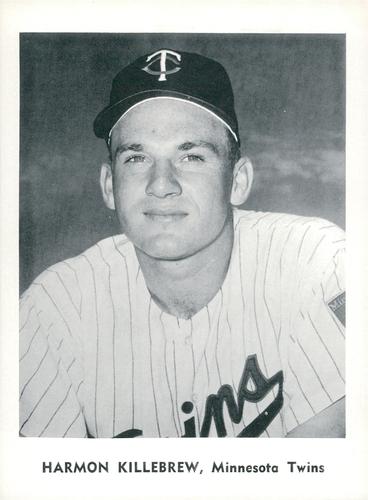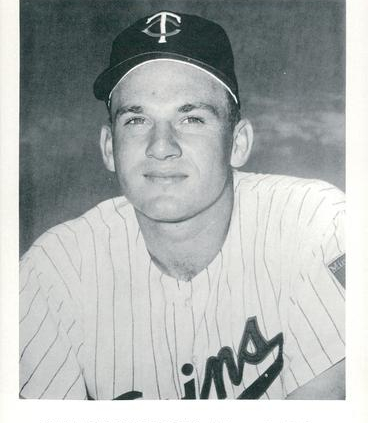August 9, 1971: Willie Mays and Harmon Killebrew delight Twins fans in exhibition
 Should a midseason exhibition be included among the greatest games in Metropolitan Stadium history? After all, as the United Press International wire service candidly pointed out, by the end of the game, “many of the Twins had left the dugout, showered and gone home.”1 If the players left early, how could the game be all that great?
Should a midseason exhibition be included among the greatest games in Metropolitan Stadium history? After all, as the United Press International wire service candidly pointed out, by the end of the game, “many of the Twins had left the dugout, showered and gone home.”1 If the players left early, how could the game be all that great?
But taking the entire night of baseball into consideration, it was an evening worthy of honor. The exhibition game between the Minnesota Twins and San Francisco Giants was just part of the festivities. A pregame home-run contest between Willie Mays and Harmon Killebrew was what made things special. Fans got to see, and salute, two of the game’s greatest players. If baseball is at its best when it entertains us, and produces memorable moments, then this night at the Met delivered.
Players must have been dreading this August 9, 1971, exhibition. The Giants and Twins were forfeiting an offday that could have been used to rest minor injuries, or reconnect with family and friends. The Giants stopped off in Minnesota on their way home from five days on the road. They had spent a long afternoon in Chicago’s Wrigley Field the day before, playing a total of 20 innings in their doubleheader against the Cubs. They were scheduled to face Montreal at Candlestick Park the following evening. The Twins had just arrived home after eight games in seven days against the White Sox, Royals, and Angels. They would battle the reigning world champion Baltimore Orioles the next three nights. No wonder players left the park early.
The fans, on the other hand, were eager to come to the ballpark. In fact, 24,719 of them showed up. Only three times all season did the Twins draw a larger audience.2 The turnout was more than twice the overall season average of 11,910 per game,3 and easily surpassed the next night’s attendance of 15,881 against first-place Baltimore.
Baseball was far different in 1971, and those differences made this game appealing to Minnesotans. Interleague play did not begin until 1997, so fans ordinarily would not see Mays and the Giants in person. Furthermore, there was nothing like ESPN or the MLB Network to saturate homes with nightly games, exotic statistics, and highlight videos featuring every team.4 Today we are awash in a sea of information and images, but at that time, people could only wonder about Killebrew versus Mays, and American League versus National League.
Another draw for some in attendance was the connection between Mays and Minneapolis. A precocious 20-year-old Mays toyed with American Association pitching while playing 35 games for the 1951 Triple-A Millers. He batted.477, drove in 30 runs, and slammed eight home runs in his brief Twin Cities stay.
The large crowd apparently caught the Twins off guard. The unexpected turnout delayed the start of the home run contest by 20 minutes to allow all the people to find their seats.5 Once seated, the fans got their money’s worth.6
The home-run contest called for three rounds of five fair balls for each batter.7 A foul ball or a swing-and-miss would not count against him. The winner would be the hitter depositing the most of his 15 chances into the seats.
This was not the first home-run clash between these two stars. Mays and Killebrew squared off 11 years earlier while participating in the television show Home Run Derby.8 The production was filmed in Los Angeles before the 1960 baseball season, and featured the top power hitters of the day. The televised contest had a much different format, but the same object: Hit as many pitches as possible over the fence. It awarded the winner $2,000 and the loser $1,000, and offered bonuses for three or more consecutive home runs. Killebrew earned $6,000 on Home Run Derby that winter,9 a nice boost to his $20,000 Washington Senators salary.10 He appeared on the show four times, winning two and losing two. Mays won three of his five televised home-run duels. In Episode 20 of the show, Mays rallied from a 5-3 deficit to defeat Killebrew 7-6.11
In this Metropolitan Stadium rematch, Mays and Killebrew needed no introduction to the man on the mound grooving pitches for them to hit. It was Minnesota native Paul Giel, who had been a teammate of Mays on the New York Giants in 1954 and 1955. After a stint in the Army, Giel rejoined Mays on the 1958 San Francisco Giants and briefly became Killebrew’s teammate on the 1961 Twins. Giel showed his pitching impartiality by wearing a Twins uniform, but a Giants cap.12 Four months later he was named athletic director of the University of Minnesota, a position he held until 1988.13
Both contestants were among the best home-run hitters ever. At the time, Mays – he turned 40 that May – had 643 career round-trippers, placing him second on the all-time home-run list behind only Babe Ruth.14 Killebrew ranked 10th on the list, with 499 home runs.15 The 35-year-old slugger had been stuck at 499 since July 25.16 On the day of the exhibition, he admitted to columnist Sid Hartman that he had been pressing for two weeks.17 His trek to the 500-home-run summit was further hindered by an injured right big toe, suffered on June 28 against Oakland, that required a special shoe to avoid aggravating the injury.18 He hit only one home run in 31 games after suffering the injury.
In round one of the contest, Mays hit his first and third fair balls into the left-field stands. Killebrew hit his third and fourth into the same area, to tie the match at 2-2.19 Mays outhomered Killebrew 2-1 in both the second and third rounds to win, 6-4.20 For this Met Stadium showdown, no prize money was awarded. Each player did raise $250 for his favorite charity, courtesy of sponsor Harold Greenwood of Midwest Federal Savings and Loan.21
Mays and Killebrew continued to delight everyone once the game began. Mays “put on a show by playing center field in the first inning, then switching to first, second, shortstop, and third before retiring in the sixth.”22 He did not get a hit in three plate appearances, but in his final at-bat he sent Jim Nettles deep in center field to catch his long drive.23
Killebrew was the hero of the Twins’ exhibition win. He ripped a game-winning three-run homer in the first inning that landed 422 feet away in the left-field stands.24 The Twins added a run each in the fifth and the seventh – the latter a home run by Rich Reese – to claim a 5-2 victory. The Twins used 15 position players and four pitchers in the game.25
Since this was an exhibition, Killebrew’s career home-run mark remained at 499 – but not for long. The next night against the Orioles, he hit number 500 in the first inning, and added number 501 in the sixth.26 When he retired after spending 1975 with the Kansas City Royals, his home-run count had reached 573.
Minnesota ended the 1971 season 76-86 – fifth in the six-team American League West – 26½ games behind first-place Oakland. It was a disappointing outcome for the Twins, who had won the division handily in 1969 and 1970.
1 “Twins Take Exhibition,” St. Cloud Times, August 10, 1971: 12
2 Larger crowds were May 9 versus Washington (28,980); July 6 versus California (26,687); July 31 versus the New York Yankees (25,560). retrosheet.org/boxesetc/1971/VMIN01971.htm.
3 The 1971 Twins drew 940,858 for 79 home games. However, they played four single-admission doubleheaders at home in 1971, bringing the average per gate to 12,545.
4 ESPN’s SportsCenter did not debut until September 7, 1979. en.wikipedia.org/wiki/History_of_ESPN. The MLB Network was founded in 1999.
5 Tom Briere, “Mays Wins Homer Duel, but Killebrew Saves One for Game,” Minneapolis Tribune, August 10, 1971: 1C
6 Briere.
7 Briere.
8 wikipedia.org/wiki/Home_Run_Derby_%28TV_series%29.
9 wikipedia.org/wiki/Home_Run_Derby_%28TV_series%29.
10 baseball-reference.com/players/k/killeha01.shtml.
11 The episode can be seen on You Tube at https://www.youtube.com/watch?v=oysfEGhEc-w. Accessed April 25, 2020.
12 Briere.
13 Cary Smith, “Paul Giel,” SABRBioProject, https://sabr.org/bioproj/person/0b986aab.
14 Briere.
15 Briere.
16 Mike Lamey, “500th – No Pressure, Mays,” Minneapolis Star, August 10, 1971: 1D.
17 Sid Hartman, “Sid Hartman,” Minneapolis Tribune, August 11, 1971: 2C.
18 Hartman.
19 Briere.
20 Briere.
21 Briere.
22 “Killebrew Gets Back at Mays,” San Francisco Examiner, August 10, 1971: 43.
23 “Twins Take Exhibition.”
24 “Killebrew Gets Back at Mays.”
25 “Box Score,” San Francisco Examiner, August 10, 1971: 43.
Additional Stats
Minnesota Twins 5
San Francisco Giants 2
Metropolitan Stadium
Bloomington, MN
Corrections? Additions?
If you can help us improve this game story, contact us.


